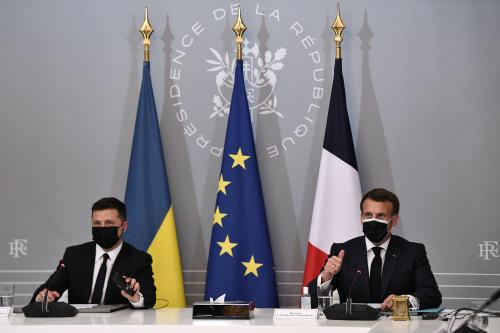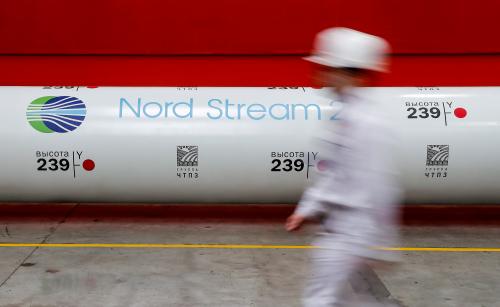Ukrainian President Zelensky’s trip to Washington can be a success for him and for U.S.-Ukraine relations, but to achieve this, he will need to bring reasonable expectations and a vision for how he will realize the ambitions of the Ukrainian people for Ukraine to become a prosperous democracy, writes Steven Pifer. This post originally appeared in the Kyiv Post.
President Volodymyr Zelensky visits Washington next week, with the highlight being a White House call on President Joe Biden. That offers the opportunity to reinvigorate the U.S.-Ukraine relationship at the highest level, following four years of Donald Trump.
This can be a very good meeting for the Ukrainian president. He should, however, take care in what he seeks. If he wants to return home with a clear success and having boosted U.S.-Ukraine relations, he should not ask for things he knows — or should know — he cannot get. Moreover, the more convincing the message that he brings regarding Kyiv’s commitment to domestic reform, the better will be his time in Washington.
August 31 will be Zelensky’s first time to the White House, even though Trump offered him such a visit more than two years ago. Sadly, the former president showed no understanding of the import of Ukraine for American national interests and instead sought to extort Kyiv into interfering in U.S. politics.
When it comes to Ukraine, Biden gets it. The discussions between the presidents will undoubtedly focus on the two central challenges facing Kyiv. First, the conflict that Russia has inflicted on Ukraine since 2014, which has claimed some 14,000 lives. Zelensky can expect a strong reiteration of American support for Ukraine, including for non-recognition of Moscow’s illegal seizure of Crimea and for a settlement in Donbas that restores Ukrainian sovereignty.
The tricky part for Zelensky will turn on the specific asks he makes.
In the past, the Ukrainian president has called for a NATO membership action plan (MAP). In one sense, that is not unreasonable. Ukraine has made as much progress as many other new alliance members had made when they received MAPs.
NATO members, however, remain reluctant to put Ukraine, when it is engaged in a low-intensity war with Russia, on a membership track — despite the fact that NATO has stated that the question of membership is between the alliance and the prospective member, not any third party, i.e., not the Kremlin. That may seem unfair in Kyiv, but it is the reality.
So Zelensky should not seek a MAP. He could ask for an intensified and continuing discussion on the practical steps that Kyiv should take now so that, when a window opens for progress toward membership, Ukraine is fully ready to seize it. Zelensky can, in effect, have a MAP … if he accepts that it will not be called a MAP.
Ukraine — the biggest potential loser when Nord Stream 2 begins operation — understandably opposes it. Biden opposes it as well but remains unready to sanction German or European companies and risk a rift with Berlin and Brussels. (Kyiv should not want such a rift, which would erode U.S.-European Union unity on supporting Ukraine and sanctions against Russia.)
Zelensky thus should not urge sanctioning European companies to block the pipeline. He should instead ask how Washington, working with Berlin, intends to build with specifics on the July U.S.-German statement on supporting Ukraine, Europe’s energy security and climate goals, and ensure that Russia will not use the pipeline against Kyiv. He could also propose continuing the discussion begun on August 23 by the Ukrainian, German, and American energy ministers about steps to strengthen Ukraine’s energy security.
Many in Kyiv have expressed frustration with the lack of progress toward settling the Donbas conflict in the “Normandy process” led by the Germans and French, and some even suggest alternative formats. Washington does not want to displace Berlin and Paris, and it benefits Kyiv to keep those key European Union members engaged. Still, Zelensky can and should press Biden to engage U.S. diplomacy more forcefully in support of the Germans and French.
He also may have an opening to ask for more. Washington reportedly has considered contingency military assistance for Ukraine. Given the Russian build-up last April, which was only partially drawn down, and the prospect that the September Zapad exercise will bring even more Russian troops close to Ukraine’s border, new U.S. military assistance would send a powerful signal of U.S. commitment to Ukraine as well as bolster its defensive capabilities.
The second central challenge facing Kyiv is putting in place the critical mass of reforms that will allow Ukraine’s economy to accelerate growth and realize its full potential, including encouraging open competition, strengthening the rule of law, curbing the outsized political and economic influence of the oligarchs, and beating back corruption. Kyiv’s record over the past two years has been mixed. These questions concerned Biden when he had the senior lead on Ukraine in the Obama administration. If Zelensky brings a credible, compelling message of his commitment to reform accompanied by specific ideas, he will find a receptive audience.
Zelensky’s U.S. visit can produce a major success for him and for U.S.-Ukraine relations. He should position himself to achieve such an outcome. That requires not overreaching by setting the bar impossibly high. And it means bringing a persuasive vision for how Kyiv will realize the ambitions of the Ukrainian people to become a prosperous democracy and a “normal” European state.








Commentary
President Zelensky comes to Washington
August 25, 2021